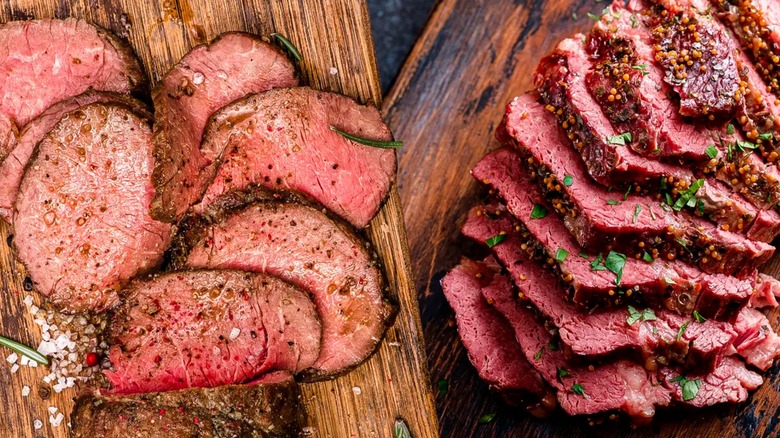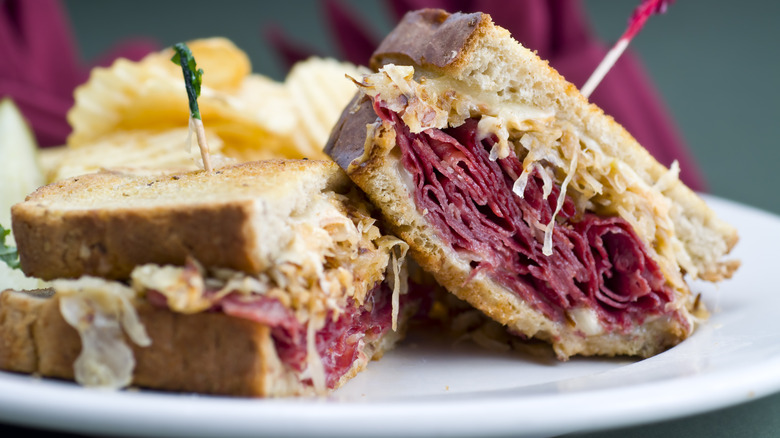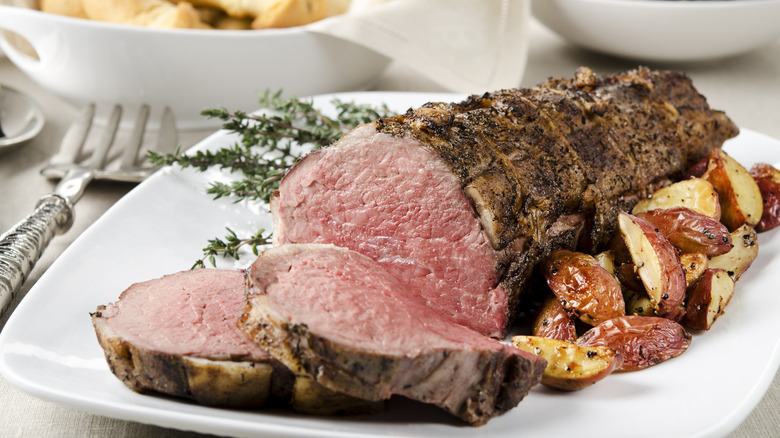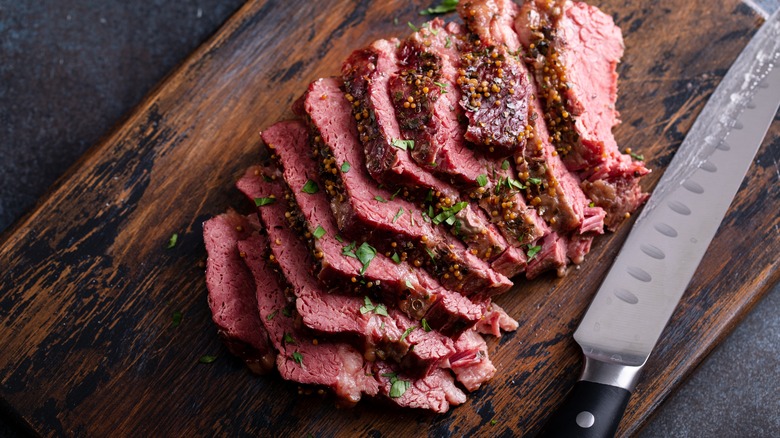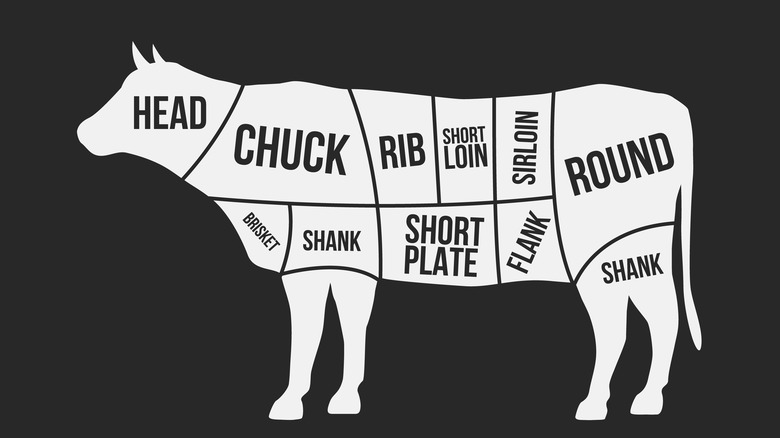Corned Beef Vs Roast Beef: The Differences You Should Know
Corned beef and roast beef are both beloved sandwich staples and make for hearty meals. These juicy pieces of meat can be sliced thin or thick, served hot or cold, and work with a variety of toppings and sides. But despite the fact that they tick so many of the same boxes, they are fundamentally different, and each has applications whereby they shine.
If corned beef makes you think of a deli, you're not alone. It has a secure place in the pantheon of deli meats, where it is often served hot, sliced to order, and presented with delicious austerity on caraway-studded rye bread with a smear of piquant mustard. If, however, corned beef makes you think of St. Patrick's Day, you're still in good company. Though not commonly eaten in Ireland for the sake of celebration, corned beef has become a classic to serve on the holiday in the U.S.
Roast beef conjures up thoughts of jolly old England, a land that loves a good Sunday roast. Served medium-rare with plenty of jus and a bracing bit of horseradish, roast beef crowns many a family gathering. What's more, the same roast can be shaved and piled onto sandwiches the next day for a meaty lunch.
Where then do they stray from each other? It's not just a matter of the cut of beef used, but rather it goes down to the methods used to prepare each and how the flavor is impacted and transformed.
What is corned beef?
Despite the name, no maize is used in the production of corned beef. Rather this wet-cured (i.e. brined) beef derives its name from the sizable kernels of salt that are used in its production. The beef — primarily beef brisket, although other cuts like round and silverside are also used — is soaked in a seasoned brine solution. This curing process gives corned beef its distinctive flavor and rosy hue. After brining, the beef is often simmered or slow-cooked until tender, resulting in a flavorful and succulent dish.
Corned beef's association with Ireland stretches back hundreds of years and owes to the Emerald Isle's bustling cattle farms, which supplied corned beef and other meat products for British markets. In regard to American delis, many of which have Jewish cultural roots, corned beef caught on thanks to the combined effects of immigration, close-knit neighborhoods, and dietary restrictions. As Irish immigrants often lived in close proximity to Jewish immigrants who kept kosher, corned beef was a popular offering at delicatessens that cut across cultural differences.
What is roast beef?
Roast beef is a classic dish cherished for its simplicity and delicious flavor. It can typically consist of any number of large cuts of lean beef, such as rump, sirloin, or tenderloin, which are seasoned liberally and roasted until tender and flavorful. Common herbs and spices used in seasoning roast beef include rosemary, thyme, garlic, and mustard.
As the name implies, roast beef is typically cooked in an oven at relatively high heat. Roasting allows the lean beef to cook evenly while developing a caramelized crust on the exterior, which adds texture and flavor. The cooking time and temperature vary depending on the cut of beef and desired level of doneness, ranging from rare to well-done. After roasting, the beef is allowed to rest before being sliced and served. This resting period allows the juices to redistribute within the meat, ensuring a tender and juicy final product. Roast beef can be served as a main course alongside vegetables, potatoes, and gravy, or sliced thinly for sandwiches where it is typically accompanied by bright, tangy ingredients such as horseradish cream or hot mustard.
Corned beef is brined
Corned beef undergoes a curing process that was once used as a method of preservation. Though modern refrigeration has rendered that moot, curing is still used to transform the appearance and flavor, giving corned beef its distinctive taste and texture. The beef is submerged in a brine solution, typically consisting of water, salt, sugar, and pickling spices like peppercorns, mustard seeds, and bay leaves. This step is essential for flavor infusion. The beef is left to soak in the brine for several days, allowing the salt and spices to penetrate the meat.
During this process, the salt in the brine first draws moisture out of the beef, effectively "curing" it. As the corned beef sits submerged, the brine and meat reach a stasis and then the flavorful brine is drawn into the meat. This results in a firmer texture and gives the meat its characteristic pink color. Additionally, the spices in the brine infuse the beef with a complex blend of flavors, ranging from peppery and tangy to subtly sweet and aromatic. Once cured, the corned beef can be cooked by simmering in water or slow-roasting until tender.
Roast beef comes from different cuts
Roast beef offers versatility in its preparation, as it can be crafted from a range of beef cuts, generally those on the leaner side, but any cut can be used technically. One popular option is sirloin, prized for its tenderness and robust taste. Additionally, cuts like the top round, bottom round, and eye of round are commonly utilized for their affordability and flavor, making them ideal for roasting to medium-rare.
Conversely, corned beef typically relies on brisket, a cut known for its rich marbling and succulent texture. Brisket's higher fat content renders it well-suited for the prolonged cooking required in the corned beef curing process. The fat helps to keep the meat moist and tender during the extended cooking time, resulting in a flavorful and melt-in-your-mouth experience. While other cuts may be used for corned beef, brisket remains the preferred choice due to its ability to withstand the lengthy brining and cooking process, ensuring a delectable end product.
